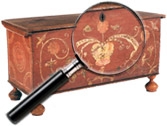Satsuma
The ancient Japanese province of Satsuma was in the southern most part of the island of Kyushu. Its association with the production of pottery and earthenware was well known by the early 17th century. It was at this time that master artisans from Korea were introduced following a series of invasions by Japan of Korea and the impress of artists into service for the Satsuma Shogunate.
By the end of the 18th century, Satsuma production had not included porcelains, and was restricted to the local clays and earthenware of the Chawan (tea bowl). However, in neighboring Arita, potters had been making finely enameled porcelain wares for many years, primarily for export. In an effort to be more competitive Satsuma missions were formed to scour Japan for techiniques of decorationg Satsuma ware. It was in Kyoto where these missions were introduced to the enamel colors that had been in use for over a hundred years. These techniques were brought back to Satsuma and revolutionized their wares. By the same token, Kyoto studios began to produce fine, artistic “Satsuma” ware.
The opening of trade with Japan, largely attributed to Commodore Perry and his so-called “Gunboat” diplomacy, created lively Western interest in Japanese arts, and demand grew at a rapid rate, most notably with the world trade exhibitions. The Paris Exhibition of 1867 was the first at which the Satsuma Province was able to exhibit under their own name.
